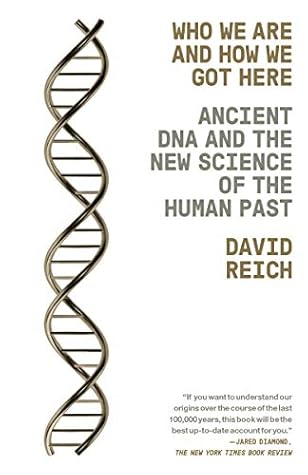More on this book
Community
Kindle Notes & Highlights
by
David Reich
Read between
March 20 - April 25, 2022
A great surprise that emerges from the genome revolution is that in the relatively recent past, human populations were just as different from each other as they are today, but that the fault lines across populations were almost unrecognizably different from today.
These mutations tell us how closely related two people are and record exquisitely precise information about the past.
The intensification of evidence for modern human behavior after fifty thousand years ago is undeniable, and raises the question of whether biological change contributed to it.
Females create an average of about forty-five new splices when producing eggs, while males create about twenty-six splices when producing sperm, for a total of about seventy-one new splices per generation.20 So it is that as we trace each generation back further into the past, a person’s genome is derived from an ever-increasing number of spliced-together ancestral fragments.
This means that our genomes hold within them a multitude of ancestors.
These calculations mean that a person’s genealogy, as reconstructed from historical records, is not the same as his or her genetic inheritance.
In 2001, the human genome was sequenced for the first time—which means that the great majority of its chemical letters were read.
Walt Whitman, in the poem “Song of Myself,” wrote, “Do I contradict myself? / Very well, then I contradict myself, / (I am large, I contain multitudes).”
Even today, many groups of modern humans keep largely to themselves because of cultural, religious, or caste barriers. Why should it have been any different for modern humans and Neanderthals when they encountered one another?
(by the word “indigenous” I refer to people who were established prior to the population movements associated with the spread of farming).
One of the most striking genomic discoveries of the past few years is a mutation in a gene that is active in red blood cells and that allows people who live in high-altitude Tibet to thrive in their oxygen-poor environment.
When confronted with the diversity of life, evolutionary biologists are drawn to the metaphor of a tree.
There was never a single trunk population in the human past. It has been mixtures all the way down.
The extraordinary fact that emerges from ancient DNA is that just five thousand years ago, the people who are now the primary ancestors of all extant northern Europeans had not yet arrived.
Genetics offers the opportunity to rediscover lost stories, and has the potential to promote not just understanding but also healing.
And archaeological and skeletal evidence shows that the one-meter-tall “Hobbits” also persisted until around this same time on Flores island in Indonesia.
These numbers imply that the contribution of European American men to the genetic makeup of the present-day African American population is about four times that of European American women.
The genomic evidence of the antiquity of inequality—between men and women, and between people of the same sex but with greater and lesser power—is sobering in light of the undeniable persistence of inequality today. One possible response might be to conclude that inequality is part of human nature and that we should just accept it. But I think the lesson is just the opposite. Constant effort to struggle against our demons—against the social and behavioral habits that are built into our biology—is one of the ennobling behaviors of which we humans as a species are capable, and which has been
...more
The real offense of racism, in the end, is to judge individuals by a supposed stereotype of their group—to ignore the fact that when applied to specific individuals, stereotypes are almost always misleading. Statements such as “You are black, you must be musical” or “You are Jewish, you must be smart” are unquestionably very harmful. Everyone is his or her own person with unique strengths and weaknesses, and should be treated as such.
After reading the Passover story, Jews intuitively understand how within their population, numbering millions of people, they are related to each other and the past. The story allows Jews to think of those millions of coreligionists as direct relations—and to treat them with equal respect and seriousness even if they do not understand their exact relationships—to break out from the trap of thinking of the world from the perspective of the relatively small families we were raised in.
Our particular ancestors are not the point. The genome revolution provides us with a shared history that, if we pay proper attention, should give us an alternative to the evils of racism and nationalism, and make us realize that we are all entitled equally to our human heritage.


